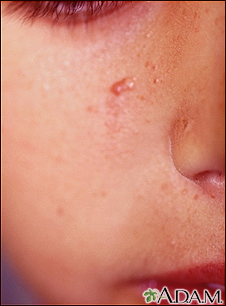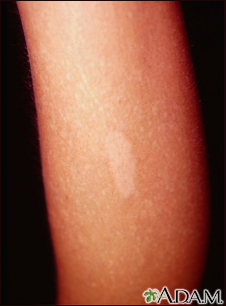Tuberous sclerosis
Bourneville disease; Tuberous sclerosis complex (TSC)
Tuberous sclerosis is a genetic disorder that affects the skin, brain/nervous system, kidneys, heart, and lungs. The condition can also cause tumors to grow in the brain. These tumors have a tuber or root-shaped appearance.
Images


Causes
Tuberous sclerosis is a genetic condition. Changes (non-working gene variants or mutations) in one of two genes, TSC1 and TSC2, are responsible for most cases.
Only one parent needs to pass on the non-working gene for the child to get the disease. However, two-thirds of cases are due to new gene changes. In most cases, there is no family history of tuberous sclerosis.
This condition is one of a group of diseases called neurocutaneous syndromes. Both the skin and central nervous system (brain and spinal cord) are involved.
There are no known risk factors, other than having a parent with tuberous sclerosis. In that case, each child has a 50% chance of inheriting the disease.
Symptoms
Skin symptoms include:
- Areas of the skin that are white (due to decreased pigment) and have either an ash leaf or confetti appearance
- Red patches on the face containing many blood vessels (facial angiofibromas)
- Raised patches of skin with an orange-peel texture (shagreen spots), often on the back
Brain symptoms include:
- Autism spectrum disorders
- Developmental delays
- Intellectual disability
- Seizures
Other symptoms include:
- Pitted tooth enamel.
- Rough growths under or around the fingernails and toenails.
- Rubbery noncancerous tumors on or around the tongue.
- Lung disease known as LAM (lymphangioleiomyomatosis). This is more common in women. In many cases, there are no symptoms. In other people, this can lead to shortness of breath, coughing blood, and lung collapse.
- A benign cardiac tumor known as a cardiac rhabdomyoma. This is common in children with tuberous sclerosis and can be seen on ultrasound before a baby is born.
The symptoms vary from person to person. Some people have normal intelligence and no seizures. Others have intellectual disabilities or difficult-to-control seizures.
Exams and Tests
Signs may include:
- Abnormal heart rhythm (arrhythmia)
- Calcium deposits in the brain
- Noncancerous tumors in the brain
- Rubbery growths on the tongue or gums
- Tumor-like growth (hamartoma) on the retina, pale patches in the eye
- Tumors in the kidneys
Tests may include:
- CT scan of the head
- Chest CT
- Echocardiogram (ultrasound of the heart)
- MRI of the head
- Ultrasound of the kidney
- Ultraviolet light examination of the skin
DNA testing for the two genes that can cause this disease (TSC1 or TSC2) is available.
Regular ultrasound checks of the kidneys are important to make sure there is no tumor growth.
Treatment
There is no known cure for tuberous sclerosis. Because the disease can differ from person to person, treatment is based on the symptoms.
- Depending on the severity of the intellectual disability, the child may need special education.
- Some seizures are controlled with medicine (vigabatrin is first line for infantile spasms). Other children may need surgery.
- Small growths on the face (facial angiofibromas) may be removed by laser treatment. These growths tend to come back, and repeat treatments will be needed.
- Cardiac rhabdomyomas commonly disappear after puberty. Surgery to remove them is usually not needed.
- Brain tumors can be treated with medicines called mTOR inhibitors (sirolimus, everolimus).
- Kidney tumors are treated with surgery, or by reducing the blood supply using special x-ray techniques. mTOR inhibitors are being studied as another treatment for kidney tumors.
Support Groups
More information and support for people with tuberous sclerosis and their families can be found at: www.tsalliance.org.
Outlook (Prognosis)
Children with mild tuberous sclerosis most often do well. However, children with severe intellectual disability or uncontrollable seizures often need lifelong assistance.
Sometimes when a child is born with severe tuberous sclerosis, one of the parents is found to have had a mild case of tuberous sclerosis that was not diagnosed.
The tumors in this disease tend to be noncancerous (benign). However, some tumors (such as kidney or brain tumors) can become cancerous.
Possible Complications
Complications may include:
- Brain tumors (astrocytoma)
- Heart tumors (rhabdomyoma)
- Severe intellectual disability
- Uncontrollable seizures
When to Contact a Medical Professional
Contact your health care provider if:
- Either side of your family has a history of tuberous sclerosis
- You notice symptoms of tuberous sclerosis in your child
Contact a genetic specialist if your child is diagnosed with a cardiac rhabdomyoma. Tuberous sclerosis is the leading cause of this tumor.
Prevention
Genetic counseling is recommended for couples who have a personal or family history of tuberous sclerosis and who want to have children.
Prenatal diagnosis is available for families with a known gene variant or history of this condition. However, tuberous sclerosis often appears as a new DNA mutation. These cases are not preventable.
Related Information
Autosomal dominantCentral nervous system
Seizures
Muscle cramps
Intellectual disability
Rashes
Brain tumor - children
References
National Institute of Neurological Disorders and Stroke website. Tuberous sclerosis complex. www.ninds.nih.gov/health-information/disorders/tuberous-sclerosis-complex. Updated July 19, 2024. Accessed September 13, 2024.
Safier RA, Cleves-Bavon C, Gaesser J. Neurology. In: Zitelli BJ, McIntire SC, Nowalk AJ, Garrison J, eds. Zitelli and Davis' Atlas of Pediatric Physical Diagnosis. 8th ed. Philadelphia, PA: Elsevier; 2023:chap 16.
Sahin M, Ullrich N, Srivastava S, Pinto A. Neurocutaneous syndromes. In: Kliegman RM, St. Geme JW, Blum NJ, et al, eds. Nelson Textbook of Pediatrics. 22nd ed. Philadelphia, PA: Elsevier; 2025:chap 636.
Tsao H, Luo S. Neurofibromatosis and tuberous sclerosis complex. In: Bolognia JL, Schaffer JV, Cerroni L, et al, eds. Dermatology. 5th ed. Philadelphia, PA: Elsevier; 2025:chap 61.
BACK TO TOPReview Date: 8/18/2024
Reviewed By: Anna C. Edens Hurst, MD, MS, Associate Professor in Medical Genetics, The University of Alabama at Birmingham, Birmingham, AL. Review provided by VeriMed Healthcare Network. Also reviewed by David C. Dugdale, MD, Medical Director, Brenda Conaway, Editorial Director, and the A.D.A.M. Editorial team.

Health Content Provider
06/01/2025
|
A.D.A.M., Inc. is accredited by URAC, for Health Content Provider (www.urac.org). URAC's accreditation program is an independent audit to verify that A.D.A.M. follows rigorous standards of quality and accountability. A.D.A.M. is among the first to achieve this important distinction for online health information and services. Learn more about A.D.A.M.'s editorial policy, editorial process and privacy policy. A.D.A.M. is also a founding member of Hi-Ethics. This site complied with the HONcode standard for trustworthy health information from 1995 to 2022, after which HON (Health On the Net, a not-for-profit organization that promoted transparent and reliable health information online) was discontinued. |
The information provided herein should not be used during any medical emergency or for the diagnosis or treatment of any medical condition. A licensed medical professional should be consulted for diagnosis and treatment of any and all medical conditions. Links to other sites are provided for information only -- they do not constitute endorsements of those other sites. © 1997- 2025 A.D.A.M., a business unit of Ebix, Inc. Any duplication or distribution of the information contained herein is strictly prohibited.
